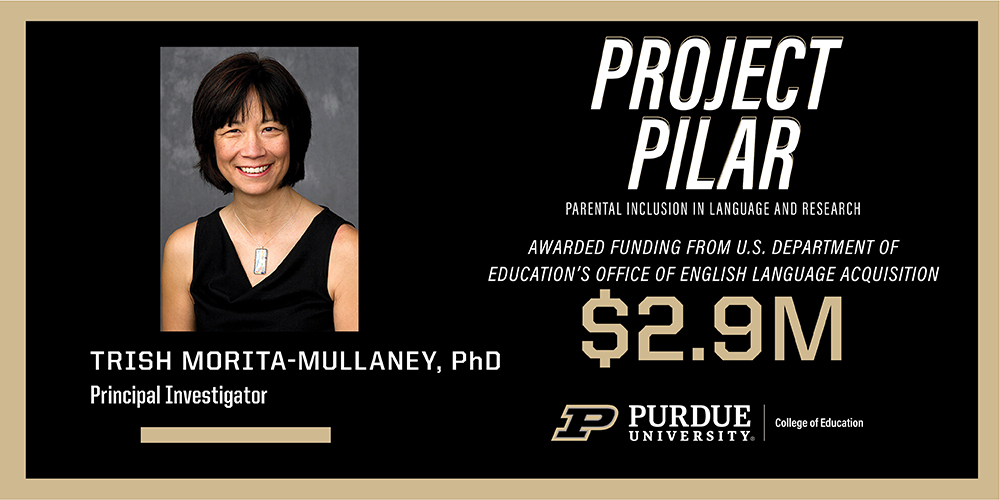Dr. Trish Morita-Mullaney leading research team awarded $2.9M by U.S. Department of Education

Researchers will work with school districts implementing dual language education models for English Learners
WEST LAFAYETTE, Indiana – Dr. Trish Morita-Mullaney, associate professor in the College of Education at Purdue University, is Principal Investigator (PI) on a recently awarded $2.9 million U.S. Department of Education grant to assist with preparation of dual language bilingual education teachers, administrators, families, and policy makers. Along with Co-PIs, Dr. Jennifer Renn and Dr. Wayne Wright, and key personnel, Dr. Virak Chan and Anne Garcia, M.S., their research will address a pressing need in the area of dual language bilingual education in pre- and in-service education.
The five-year grant, Parental Inclusion in Language and Research, or Project PILAR, works with school districts who are implementing dual language education models for their English learners. Dual language bilingual education (DLBE) purposefully blends English majority and English learners together, teaching them in two languages. To date, Indiana schools have 33 such dual language models, mostly teaching in English and Spanish.

Dr. Trish Morita-Mullaney, associate professor in the College of Education
“We work really hard to make our bilingual English learners monolingual in our schools, because our instruction is in English only,” said Morita-Mullaney. “A dual language education ensures that their bilingualism is maintained and developed. This model furnishes English learners not only with bilingual proficiency, but also affords them a strong sense of belonging—central to their continued education and civic engagement.”
Dual language teachers in the MSD of Lawrence and School City of Hammond will receive English learner licensure as well as a graduate dual language bilingual education certificate. Dr. Jennifer Renn, Associate Research Scientist and Co-PI, discussed the impact of coursework and instructional coaching on its dual language teachers.
“Dual language bilingual education is relatively new to Indiana, so dual language teachers are hungry for support and training that will help them effectively serve their students,” explained Renn. “The courses in the English learner and dual language programs are designed to meet the needs of these teachers, and the instructional coach does a fantastic job of tailoring her feedback to each person.” Renn noted that teachers will graduate from this program with a deeper knowledge of language and literacy development, tools to support DLBE students, and increased confidence in their ability to teach and advocate for their students.
This new research expands the work of Morita-Mullaney’s previously funded USDE projects, where she and her team have already licensed over 100 teachers in English learner of dual language education.
La Plaza and the Hammond Hispanic Community Council will work with families participating in dual language education to identify the ways in which the program model has shaped the educational possibilities for their children.
Anne Garcia, the Family, Community, and School Engagement Manager for Project PILAR stated, “Families are already pivotal in the bilingual development of their children. In collaboration with our community partners, we look forward to finding out the many creative ways families are already promoting and developing bilingualism.”
The enduring component of Project PILAR is its strategic focus on policy change. By working with educational services centers and policy agencies, the Indiana Department of Education and Indiana Teachers of English to Speakers of Other Languages, and Indiana’s Educational Services Centers, language policies will be directly addressed.
“Educational policies seldom recognize the bilingual skills of our English learners,” explained Dr. Wayne Wright, the Barbara I. Cook Chair of Literacy and Language, Professor, Associate Dean, and Co-PI of the study. “Project PILAR’s educators and families will help us identify the needs within this type of model, so policy can be specifically crafted to address the growing needs of Indiana’s English learners.”
Morita-Mullaney shared, “PILAR is just like it sounds. A pillar. In Spanish, a pilar. The project asserts that families are the pillars of the bilingual identities of their children, and it is from this grounding that we inform teacher education and policy transformation.”
Sources: Trish Morita-Mullaney, 765-496-1622, tmoritam@purdue.edu

The Jimenez family reside in Frankfort, Indiana, where their elementary school sons participate in the Project Leveraging la Lectura y Lenguaje, a Purdue University program that supports English language learners, their families, teachers, and administrators in Central Indiana.